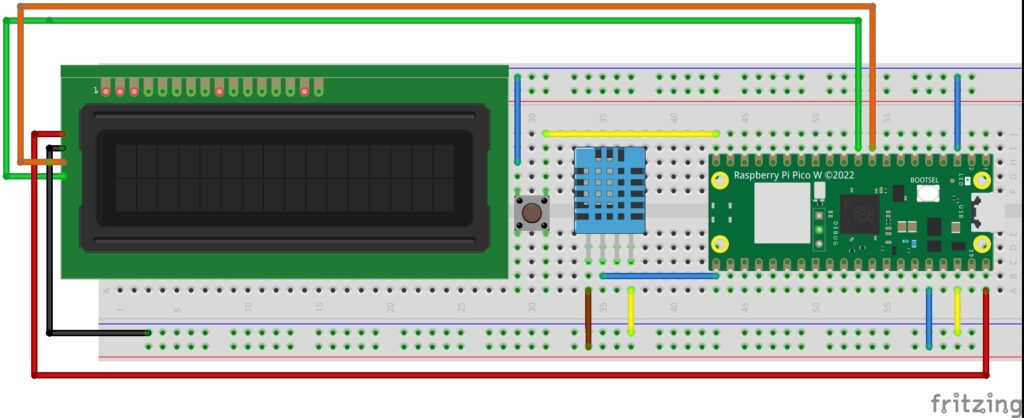In this video lesson, we create a mobile sensorless weather station. This is a follow on from our earlier lesson, and with this class, we add a rechargeable LiPo Battery, and an OLED screen. For your convenience, we show the code below that was developed in this video.
1 2 3 4 5 6 7 8 9 10 11 12 13 14 15 16 17 18 19 20 21 22 23 24 25 26 27 28 29 30 31 32 33 34 35 36 37 38 39 40 41 42 43 44 45 46 47 48 49 50 51 52 53 54 55 56 57 58 59 60 61 62 63 64 65 66 67 68 69 70 | import network import time import secrets import urequests from machine import Pin, I2C from ssd1306 import SSD1306_I2C i2c=I2C(1,sda=Pin(2),scl=Pin(3), freq=400000) dsp=SSD1306_I2C(128,64,i2c) wlan=network.WLAN(network.STA_IF) wlan.active(True) wlan.connect(secrets.SSID,secrets.PASSWORD) while wlan.isconnected()==False: print('Connecting . . .') print('Congratulations, You Have Connected') #weather=urequests.get("https://api.openweathermap.org/data/2.5/weather?lat=0.478623&lon=33.164364&appid=0d631313b55e6e128285fd7882ba913f&units=imperial").json() weather=urequests.get("https://api.openweathermap.org/data/2.5/weather?q=Jinja,Uganda&appid=0d631313b55e6e128285fd7882ba913f&units=imperial").json() tm=time.localtime(weather['dt']+weather['timezone']) print('Welcome to '+weather['name']+', '+weather['sys']['country']) print('Local Time: '+str(tm[3])+':'+str(tm[4])+' '+str(tm[1])+'/'+str(tm[2])+'/'+str(tm[0])) sr=time.localtime(weather['sys']['sunrise']+weather['timezone']) print('Sunrise at: '+str(sr[3])+':'+str(sr[4])) ss=time.localtime(weather['sys']['sunset']+weather['timezone']) print('Sunset at: '+str(ss[3]-12)+':'+str(ss[4])+' PM') print('Current Temp: '+str(weather['main']['temp'])+' F') print('Current Humidity: '+str(weather['main']['humidity'])+' %') print('Current Barometric Pressure: '+str(weather['main']['pressure']*0.0009869233)+' ATM') for i in range(len(weather['weather'])): print('Current Conditions: '+weather['weather'][i]['main']+', '+weather['weather'][i]['description']) print('Wind: '+str(weather['wind']['speed'])+' MPH') myTime=time.time() while True: if time.time()-myTime>300: weather=urequests.get("https://api.openweathermap.org/data/2.5/weather?q=Jinja,Uganda&appid=0d631313b55e6e128285fd7882ba913f&units=imperial").json() tm=time.localtime(weather['dt']+weather['timezone']) ss=time.localtime(weather['sys']['sunset']+weather['timezone']) myTime=time.time() print('New Data Read') dsp.text('Welcome to '+weather['name'],0,0) sr=time.localtime(weather['sys']['sunrise']+weather['timezone']) dsp.text('Time: '+str(tm[3])+':'+str(tm[4]),0,16) dsp.text('Date: '+str(tm[1])+'/'+str(tm[2])+'/'+str(tm[0]),0,26) dsp.text('Sunrise: '+str(sr[3])+':'+str(sr[4]),0,36) dsp.text('Sunset: '+str(ss[3]-12)+':'+str(ss[4])+' PM',0,46) dsp.show() time.sleep(5) dsp.fill(0) dsp.text('Welcome to '+weather['name'],0,0) dsp.text('Weather: ',0,16) dsp.text('Temp: '+str(weather['main']['temp'])+' F',0,26) dsp.text('Humidity: '+str(weather['main']['humidity'])+' %',0,36) dsp.text('BP: '+str(weather['main']['pressure']*0.0009869233)+' ATM',0,46) dsp.text('Wind: '+str(weather['wind']['speed'])+' MPH',0,56) dsp.show() time.sleep(5) dsp.fill(0) dsp.text('Welcome to '+weather['name'],0,0) dsp.text('Conditions: ',0,16) row=26 for i in range(len(weather['weather'])): dsp.text(weather['weather'][i]['main'],0,row) row=row+10 dsp.text(weather['weather'][i]['description'],0,row) row=row+10 dsp.show() time.sleep(5) dsp.fill(0) |


